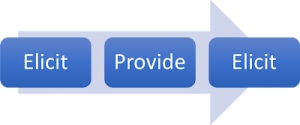Advice, we heard recently, is criticism given in a cashmere sweater. And we give advice so casually in everyday conversation. The intent is admirable; seemingly, we want to help people who are struggling with a decision, an action, a goal or desire etc. Novelist Erica Jong opined, “advice is what we ask for when we already know the answer but wish we didn’t” and there is truth in her wisdom. In motivational interviewing, following its characterization as arranging conversations so that people talk themselves into change based on their own values and interests, it is so tempting to give unsolicited advice. As interviewers, it is particularly magnetic to give advice when we have been in or had experience with similar situations as our clients. In MI circles, we are taught to resist the righting reflex, that is, to be mindful of not providing solutions or trying to fix our clients’ situations. In some cases, clients actually might be seeking advice. How can we know if our clients truly want our advice? The simple answer is, ask them. In MI, when its architects, Miller and Rollnick conceived and taught the process, they promoted what has become a kind of bellwether acronym for learning, teaching, and doing MI – the OARS‘ signifier. If you boil MI down to its basic tactics, the result would be: asking Open-ended questions; Affirming (or Acknowledging); Reflecting back; and Summarizing ~ OARS. A few years ago, In response to input from their colleagues, Miller and Rollnick added a kind of bracketed 5th component to the OARS’ acronym – [advising…with permission]. Apparently, insights provided by MI practitioners along with their own experience combined to re-frame Miller and Rollnick’s views on providing advice. Thus, in the spirit of MI, they tweaked an existing technique’s use into a kind of paradigm or template for integrating advice into MI conversations. What is now utilized as a framework for advice-giving when doing MI is this phraseology: Elicit ~ Provide ~ Elicit (EPE). If you reach a point in an MI session where you intuit that your advice might serve your client, first, seek your client’s permission to give it. For example, you might say, ‘I’ve worked with other clients who faced a similar choice/situation you are now facing and I sense that hearing about their experience might be useful for you – would you care to hear it?’ Thus, you Elicit their interest and potential permission to provide that experience as useful information for your client. The key in using this method is to be unattached to the answer. That is, if your client says, ‘no’ then we must honour their no; that ‘no’ simply might mean they aren’t ready to hear it, don’t want to hear it, don’t need to hear it. Whatever the case, no is no and as interviewer, move the conversation in another direction. If the answer is yes, then Provide the advice/experience to the client. Once you have done so, one trap might be to assume that your example is a good one or relevant or helpful. What cements the advice provision is getting genuinely curious about how your client perceives it and so you Elicit their reflection or thoughts about the advice. You might ask, ‘what insight do you have from that advice?’ or ‘how do you see integrating something like that into your behaviour goals?’ In utilizing E~P~E as a process for inserting advice into an MI session, the choice is left with the client both about hearing the advice and about their re-framing or adapting the advice into something useful for them. If we truly believe that clients will “talk themselves into change based on their own values and interests,” then they will know how well or even if the advice might be beneficial for them. The EPE model is used in many different ways in MI; in this case, in seeking potential permission to provide advice, the idea is summed up in this diagram:
The intent, as always in MI, as the arrow in the diagram above suggests is to move the conversation forward in service of drawing your client’s own, internal motivation out of them either by creating learning (most MI conversations) and/or getting them into a behaviour change action. Advice can be potent if our clients have complete choice in hearing it and, if they see fit, integrating it. What do you think about this E~P~E advice suggestion? How do you perceive integrating it into your MI sessions?

